
Freshwater is a national park in Queensland, Australia, 34 km north of Brisbane. The park is west of Redcliffe, near Deception Bay, within Caboolture Shire.

Grevillea is a diverse genus of about 360 species of evergreen flowering plants in the family Proteaceae, native to rainforest and more open habitats in Australia, New Guinea, New Caledonia, Sulawesi and other Indonesian islands east of the Wallace Line. It was named in honour of Charles Francis Greville. The species range from prostrate shrubs less than 50 cm (20 in) tall to trees 35 m (115 ft) tall. Common names include grevillea, spider flower, silky oak and toothbrush plant. Closely related to the genus Hakea, the genus gives its name to the subfamily Grevilleoideae.

Grevillea robusta, commonly known as the southern silky oak, silk oak or silky oak, silver oak or Australian silver oak, is a flowering plant in the family Proteaceae. It is a tree, the largest species in its genus but is not closely related to the true oaks, Quercus. It is a native of eastern coastal Australia, growing in riverine, subtropical and dry rainforest environments.
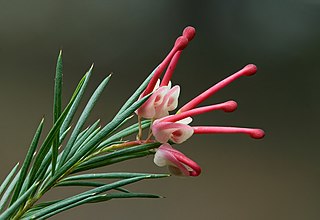
Grevillea rosmarinifolia, the rosemary grevillea, is a plant of the family Proteaceae.
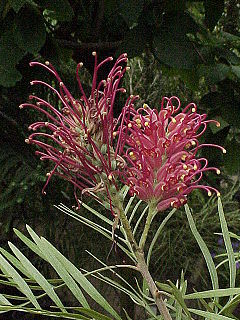
Grevillea banksii, known by various common names including red silky oak, dwarf silky oak, Banks' grevillea, Byfield waratah and, in Hawaii, Kahili flower or Kahili tree. It is a plant of the large genus Grevillea in the diverse family Proteaceae. Native to Queensland, it has been a popular garden plant for many years though has been superseded somewhat horticulturally by smaller and more floriferous hybrids. A white-flowered form G. banksii fo. albiflora is known as white silky oak.
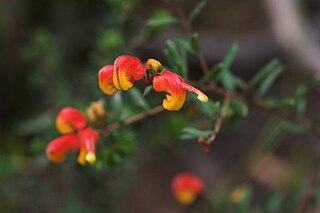
The Australian flowering shrub Grevillea alpina has several common names, including mountain grevillea, alpine grevillea, and cat's claws. It is not limited to alpine environments, and in fact is less common at high elevation than low. The species is variable in appearance, with five general forms described: small-flowered, Grampians, Northern Victorian, Goldfields, and Southern Hills forms. It is found in dry forests and woodlands across Victoria and into southern New South Wales.
Some forms of the plant are low to the ground, and some become a spreading shrub. The flowers come in many colours, from white to green to shades of red and pink, or a pattern of several colours. The curled flowers are 1 to 3 centimeters in length. It is attractive to nectar-feeding insects and birds.
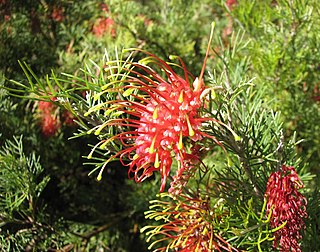
Grevillea thelemanniana, the spider-net grevillea or hummingbird bush, is a small, spreading shrub endemic to Western Australia.
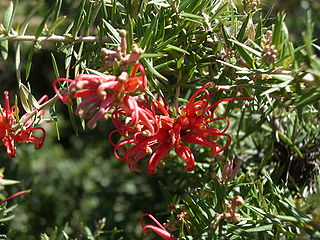
Grevillea juniperina, commonly known as juniper- or juniper-leaf grevillea or prickly spider-flower, is a plant of the family Proteaceae native to eastern New South Wales and south-eastern Queensland in Australia. Scottish botanist Robert Brown described the species in 1810, and seven subspecies are recognised. One subspecies, G. j. juniperina, is restricted to Western Sydney and environs and is threatened by loss of habitat and housing development.
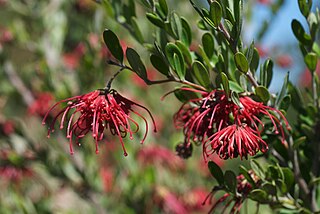
Grevillea speciosa, also known as red spider flower, is a shrub which is endemic to New South Wales in Australia.

Grevillea acanthifolia, commonly known as the Acanthus-leaved grevillea, is a plant in the Proteaceae family and is endemic to New South Wales. It is a shrub with stiff, prickly, divided leaves and pink to purple "toothbrush" flowers.

Grevillea bipinnatifida, also known as fuchsia grevillea, is a shrub which is endemic to Western Australia.
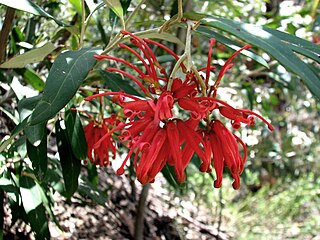
Grevillea victoriae, also known as royal grevillea or mountain grevillea, is a shrub which is endemic to south-eastern New South Wales and mountainous parts of Victoria in Australia.
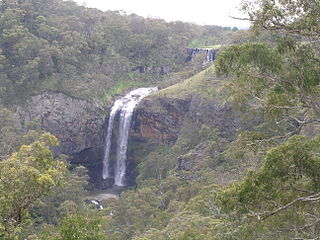
Guy Fawkes River, a perennial stream that is part of the Clarence River catchment, is in the New England and Northern Tablelands districts of New South Wales, Australia.

Grevillea iaspicula, also known as Wee Jasper grevillea, is an endangered shrub species that is endemic to southern New South Wales in Australia.
Grevillea pteridifolia is a species of Grevillea native to Australia. Common names include silky grevillea, Darwin silky oak, ferny-leaved silky oak, fern-leaved grevillea, golden grevillea, golden tree and golden parrot tree. It occurs in Western Australia, Northern Territory, and Queensland.
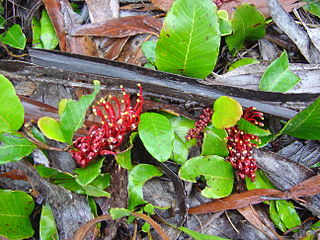
Grevillea laurifolia, commonly known as the laurel-leaf grevillea, is a spreading prostrate shrub native to eastern Australia.

Grevillea ilicifolia, commonly known as holly grevillea, is a species of the plant genus Grevillea. It is a shrub of variable form, growing to between 0.3 and 2 metres in height and 3 metres wide. Typically, leaves are lobed and holly like, but may also be unlobed. The flowers have perianths that have a base that is cream to green grading to grey-mauve. Styles may be pink, red, orange or yellow.The main flowering period in the species native range is September to November.
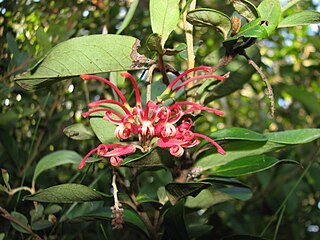
Grevillea miqueliana, commonly known as oval-leaf grevillea, is a shrub that is endemic to mountainous areas of eastern Victoria in Australia. It grows to between 1.5 and 2.5 metres in height. The species was first formally described by botanist Ferdinand von Mueller, his description published in Transactions of the Philosophical Society of Victoria in 1855. The species epithet honours Dutch botanist Friedrich Anton Wilhelm Miquel (1811-1871).
















